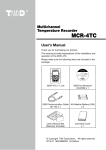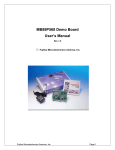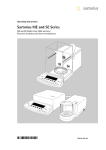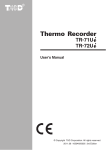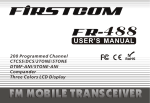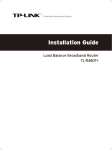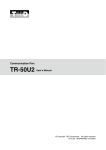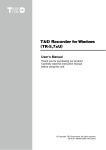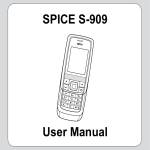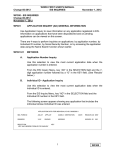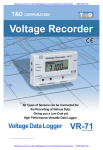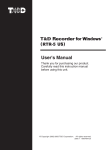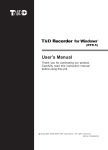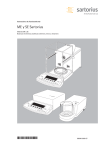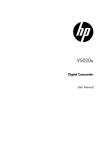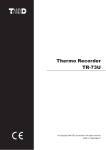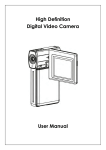Download TandD MCR-4V User Manual
Transcript
® Distributed by MicroDAQ.com, Ltd www.MicroDAQ.com (603) 746-5524 User’s Manual Thank you for purchasing our product. This manual provides explanations of the installation and operation of the MCR-4V. Please make sure the following items are included in the package. MCR-4V x 1 unit MCR for Windows CD-ROM x 1 USB Communication Cable AA Alkaline Battery (LR6) (US-15C) x 1 x2 ® 取扱 MCR4V 1 台 取扱説 添付資 明書 ・保証書 料(2種) USB 通信ケ US-15 ーブル C 1本 ight 4 16504 T&D Corpo 82000 4(第ration. 2 版)All 説明 お買い 本書で て説明 上げあ パッケ は ている してい MCR- りがと ージに 4V か確認 ます。 うござ 本体の は以下 してく います 取り扱 の物が ださい 。 いおよ 含まれ 。 び使用 ていま 方法に す。す つい べて入 っ 書 MCRCD-RO 4V 単 各1部 (本書) for M 1Windo 枚 ws 3 アルカ 2本 © Copyr 2013.0 リ電池 rights reserv ed. User’s Manual Set (Warranty Included) Card Slot Cover x 1 © Copyright T&D Corporation. All rights reserved. 2013.11 16504820008 1st Edition Distributed by MicroDAQ.com, Ltd www.MicroDAQ.com (603) 746-5524 Important Notices and Disclaimers In order to properly use this product, please carefully read all documents that accompany the product before using. T&D Corporation accepts no responsibility for any malfunction of and/or trouble with this product or with your computer that is caused by the improper handling of this product and will deem such trouble or malfunction as falling outside the conditions for free repair outlined in the attached warranty. -- All rights of the attached documents belong to T&D Corporation. It is prohibited to use, duplicate and/or arrange a part or whole of the attached documents without the permission of T&D Corporation. -- Microsoft and Windows are registered trademarks of Microsoft Corporation in the United States and/or other countries. -- Windows Vista is either a registered trademark or trademark of Microsoft Corporation in the United States and/or other countries. -- All registered trademarks, company names, product names and logos mentioned herein or for products being used are the property of T&D Corporation or of their respective owners. -- Specifications, design and other contents outlined in the attached documents are subject to change without notice. -- Please follow the safety precautions outlined in the attached documents carefully. We cannot guarantee nor are we responsible for safety if this product is used in any manner other than was intended. -- On-screen messages in the attached documents may vary slightly from the actual messages. -- Please notify the shop where you purchased this product or T&D Corporation of any mistakes, errors or unclear explanations in the attached documents. -- T&D Corporation accepts no responsibility for any damage or loss of income caused by the use of our product. -- Accompanying documents cannot be reissued, so please keep them in a safe place. -- Please read the warranty and provisions for free repair carefully. Distributed by MicroDAQ.com, Ltd www.MicroDAQ.com (603) 746-5524 Safety Precautions and Instructions Safety Precautions and Instructions The following items should be strictly obeyed for the safe usage of this product, and for protecting yourself and other people from bodily harm and/or damage to property. Explanation of Symbols Warning Symbols DANGER These entries are actions that absolutely under no circumstance should be taken. The taking of such an action may cause serious personal physical damage or death. CAUTION These entries are actions that if taken may lead to physical injury or damage to persons or things. Picture Symbols Denotes an important warning or caution. Denotes a forbidden action. Denotes an action that should be carried out. 1 Distributed by MicroDAQ.com, Ltd DANGER www.MicroDAQ.com (603) 746-5524 To Prevent Serious Accidents Do not disassemble, repair or modify the unit and accessories. Do not use the unit in any environment that is exposed to chemicals and harmful gases. Doing so may cause corrosion and/ or other danger to the unit. Also, coming in contact with hazardous substances may cause bodily harm to the user or people nearby. This unit is not water resistant. If water or a foreign object enters the case, immediately unplug the AC adaptor and stop using it. Do not handle the unit, remove batteries or cables with wet hands. This product has been designed for private and/or industrial use only. It should not be used in situations where strict safety precautions are necessary such as with medical equipment, or in systems directly or indirectly connected with human life or well-being. Do not drop or expose the unit to a strong impact. Do not cut or process the cords for the communication cables. Also, do not twist, pull on or swing any of the cords. To prevent damage to the unit from static electricity, remove static electricity from your body by touching metal around you (such as a door knob and window frame) before touching the unit. Place and store the unit and accessories out of the reach of children. Do not use any power, battery, sensor, or cable other than those specified by T&D Corporation. 2 Distributed by MicroDAQ.com, Ltd www.MicroDAQ.com (603) 746-5524 We are not responsible for any damage, malfunction or trouble, whether direct or indirect, caused by the use of our product. Do not put anything on top of the cable. This may cause overheating. Do not disconnect the USB cable during USB communication. Doing so may cause adverse effects to the unit and/or PC. Make sure that all cable plugs are inserted fully, so as not to cause an improper connection. Also, when unplugging the cable from the unit, do not pull the cord, but hold the connector to disconnect. If the unit produces heat, emits smoke or a strange smell, or makes unusual noises, immediately remove the batteries, unplug the power, and stop using it. Also, unplug the unit from the PC. If the unit is not to be used for a long period of time, remove batteries. If left in the unit, the batteries may leak and lead to malfunctioning. Install new batteries when starting or re-starting to use a unit. If there is a possibility that high voltage pulses which exceed the measurement range may be applied, make ground connections, either directly or with the surge arrester. Make sure that there is no magnetic media or materials within one meter from the device. Magnetic materials may cause damage to data stored in magnetic media. Do not remove the SD card or turn off the power while writing data to the SD card. This may result in damage to data. Do not apply voltages higher than ±50V to the earth or terminals. It may cause electrification or malfunction. 3 Distributed by MicroDAQ.com, Ltd CAUTION www.MicroDAQ.com (603) 746-5524 Do not place or store in the following areas: •Areas exposed to direct sunlight •Areas exposed to excessive heat or high temperatures such as near fire or heating equipment •Areas exposed to static electricity •Areas exposed to strong magnetic fields •Areas exposed to dampness •Areas subject to condensation or wet areas •Areas exposed to excessive vibration •Areas exposed to excessive smoke, dust or dirt. CAUTION Other Precautions •Use the unit in the specified operating environment. Do not use it for any purpose other than for which it was designed. •Condensation may occur inside the case when a unit is moved from one environment to another where there is a great difference in temperature. •Do not use the unit in wet areas or places exposed to water such as bathroom. •When connecting the unit to your PC, make sure to follow all warnings and directions from your computer manufacturer. •We shall not guarantee the unit's operation if it has been connected to a PC using a USB hub or a USB extension cable. •Please take extra caution when plugging in and pulling out the USB plug while another USB device such as CDD or HDD is in operation. •Do not insert any foreign objects into any of the units' jacks. •If the unit gets dirty, wipe it with a clean cloth. •Make sure to remove dust and dirt from plugs of any cables. •Battery terminals may provide insufficient contact due to age or vibration. This may lead to data loss. •If the unit is not to be used for a long period of time, for safety reasons please remove the battery. If left in the unit, the battery may leak and lead to malfunctioning. •When an SD card is not inserted, insert the supplied card slot cover to prevent the intrusion of dust. 4 Distributed by MicroDAQ.com, Ltd www.MicroDAQ.com (603) 746-5524 Before Using this Product Please be careful about the procedures for Installation. (For USB communication between your computer and a MCR-4V) In order to use a USB connection to communicate between the unit and a computer, it is necessary to install the software and the USB device driver. Make sure to first install the software and the USB device driver before connecting the unit to a computer. If you connect the unit first, the USB device driver may not be installed properly. If you have connected the unit to your computer before installing the USB device driver, make sure to click the [Cancel] button in the Wizard window when it pops up on the computer display. Then disconnect the USB communication cable from the unit. See p.57 for more information about the USB driver installation (Windows XP). 5 Distributed by MicroDAQ.com, Ltd www.MicroDAQ.com (603) 746-5524 Table of Contents Safety Precautions and Instructions-------------------------- 1 Before Using this Product------------------------------------- 5 Using MCR-4V Overview------------------------------------------------------------------- 8 Basic Procedures----------------------------------------------- 9 Appearance Diagram and Part Names---------------------- 10 Touch Panel--------------------------------------------------------------- 11 Touch Panel Operation Methods---------------------------------------- 12 LCD Display and Icons--------------------------------------------------- 13 Installing the Battery------------------------------------------ 15 Usable Power Sources--------------------------------------------------- 15 Changing the Batteries--------------------------------------------------- 15 Measuring Voltage--------------------------------------------- 16 About the Measurements Display--------------------------------------- 16 About the Trend Graph Display------------------------------------------ 17 Operating the Trend Graph---------------------------------------------- 18 Recording with MCR-4V: An Outline------------------------- 19 How to Use an SD Memory Card--------------------------------------- 19 Increasing Recording Channels------------------------------ 20 Storage Location for Group Recording--------------------------------- 20 Group Operations via Master-------------------------------------------- 21 Starting Recording by Group-------------------------------------------- 22 Stopping Recording by Group------------------------------------------ 22 About Menus [Record Settings] Menu--------------------------------------- 23 [Data List] Menu----------------------------------------------- 25 Displayed Items when Recording Stopped:---------------------------- 25 Displayed Items during Endless Recording:---------------------------- 26 [Memory Card] Menu------------------------------------------ 27 [Operation Settings] Menu------------------------------------ 28 Explanation of Items in Each Menu-------------------------- 29 6 Distributed by MicroDAQ.com, Ltd www.MicroDAQ.com (603) 746-5524 [Data List] Menu Items (when recording stopped)--------------------- 36 How to Read Recorded Data Graph------------------------------------ 38 [Data List] Menu Items (during endless recording)--------------------- 40 Using MCR-4V [Record Settings] Menu Items------------------------------------------- 29 [Memory Card] Menu Items---------------------------------------------- 42 [Operation Settings] Menu Items---------------------------------------- 43 Using a PC with MCR-4V Connecting the Device to a PC------------------------------- 47 Making Settings via PC--------------------------------------- 48 Channel Name------------------------------------------------------------ 48 Scale Conversion Equation---------------------------------------------- 48 About Menus Installing the Supplied Software----------------------------- 45 Unit Settings-------------------------------------------------------------- 48 Downloading Recorded Data to a PC------------------------ 49 Download Recorded Data using “MCR for Windows”---------------- 49 Analyzing Recorded Data------------------------------------- 52 Open Recorded Data----------------------------------------------------- 52 Print Graphs-------------------------------------------------------------- 52 Other Troubleshooting------------------------------------------------ 53 How to Install the USB Driver (Windows XP)--------------------------- 57 Specifications-------------------------------------------------- 58 Using a PC with MCR-4V Recorded Data File------------------------------------------------------- 50 Download Recorded Data from all Connected MCR-4V Units------- 51 MCR-4V------------------------------------------------------------------- 58 Software (MCR for Windows)-------------------------------------------- 60 Other 7 Distributed by MicroDAQ.com, Ltd www.MicroDAQ.com (603) 746-5524 Using MCR-4V Overview The MCR-4V is a multi-channel voltage data logger. It measures and records voltage, and the data can be easily displayed in graph form, enabling the immediate on-the-sport checking of continually-changing data. Measure and Record Use “MCR for Windows” for - Device Settings - Recording Settings - Downloading Recorded Data Use “T&D Graph” for - Graph Display - Data Analysis - Printing and Saving in Text SD Memory Card or USB Connection Measurements and Trend Graph Main Features in Rec Settings - Average Value Recording - 50-60Hz Filter - Increase of Number of Channels - Preheat - Recording Stop Trigger Device Coupling Image Master Slaves Throughout this manual, the MCR-4V is also referred to as “the device” or “the unit”. 8 Distributed by MicroDAQ.com, Ltd www.MicroDAQ.com (603) 746-5524 The following shows the basic flow of procedures. Use MCR-4V Use PC 111Getting Device Ready Install the batteries (see p.15) Using MCR-4V Basic Procedures 222Getting PC Ready Install the provided software (see p.45) Connect the device to a PC (see p.47) 333Setting up the Device (see p.28)/ Making Recording Settings (see p.23) * Recording Settings can be made both on the device and from a PC. 444Measuring and Recording 555Viewing Recorded Data in Graph on the Device (see p.38) 666Downloading Recorded Data to a PC Exporting data to an SD memory card and transferring to a PC. (see p.36) Using the supplied software “MCR for Windows” (see p.49) * Either of the above can be used to download recorded data to a PC. 777Analyzing Recorded Data on a PC (see p.52) View Graph, Print, Save in Text When not using a PC, the only necessary steps are 1 and 3 to 5 . 9 Distributed by MicroDAQ.com, Ltd www.MicroDAQ.com (603) 746-5524 Appearance Diagram and Part Names [TOP] 1. 2. 3. 4. 8. 5. [FRONT] 6. 7. [BOTTOM] 10 [SIDE] [BACK] 1. Preheat Terminal 2. Input Terminal 3. Coupling Lug 4. LCD Display 5. Touch Panel (touchpad and control wheel) 6. SD Memory Card Slot 7. USB Port 8. Battery Cover Distributed by MicroDAQ.com, Ltd www.MicroDAQ.com (603) 746-5524 Press to change the selected menu or settings item (by going up or down), and to increase or decrease the values shown in the LCD. Using MCR-4V Touch Panel Press to confirm the selected menu, operation, or value. Press to jump to the [Start Recording] or [Stop Recording] menu.* Press to return to the previous screen in the menu* or cancel the current operation.* Press and hold to turn the power ON/OFF. Press to switch the display between [Menu] - [Measurements] - [Trend Graph]. Press to switch between the touchpad operation and control wheel operation. Press and hold to switch the key lock ON/OFF. * Will not function when operating by control wheel. 11 Distributed by MicroDAQ.com, Ltd www.MicroDAQ.com (603) 746-5524 Touch Panel Operation Methods There are two ways to operate the touch panel as follows: --Touchpad operation --Control wheel operation Terms and gestures related to operations Tap (touch) Tap desired area of touch panel. Press-and-hold (hold down) Control Wheel Operation (rotate) Touch the screen and hold finger in place for a few seconds. Mainly used to switch ON/OFF the power and key lock. Press and rotate the control wheel (white circular area). Clockwise movement moves (up) and counterclockwise movement moves (down). IMPORTANT - -During operation, if none of the above gestures are performed for a while, the operation will be canceled and the screen will return to the original value or previous screen. - -Make sure to use a bare finger to operate the touch panel. If you use the tip of your fingernail, gloves, or touch pen, touch panel operations may not be recognized. Auto Power Off Function If the device is not used for about three minutes, it will automatically turn off to save battery power. However, the Auto Power Off function will be disabled in any of the following situations. --When a recording session is in progress --When measurements or trend graphs are displayed on the screen --When running on external power 12 Distributed by MicroDAQ.com, Ltd www.MicroDAQ.com (603) 746-5524 The following contains some brief explanations about icons. Each menu will be explained later in the “Menu List” pages. 1 2 LCD backlight will be ON during operation. 7 8 7 3 4 5 6 Using MCR-4V LCD Display and Icons A highlighted display shows the item currently selected, and a blinking highlight shows that an item is being changed. 1 Recording Status Shows the recording status. REC: Recording in progress STP: Recording stopped PRG: Waiting for programmed start IMM: Preparing immediate start TRG: Stopped by trigger 2 Recording Mode Shows the recording mode. : Endless mode : One-Time mode 3 Recording Interval Shows the recording interval. ms : millisecond(s) sec : second(s) min : minute(s) When the recording method is Average, “Aver.” and the recording interval are displayed alternatingly. When the recording method is Ave.Fine, “Ave.f” and the recording interval are displayed alternatingly. 4 Recording Channels Shows the channel(s) being measured and recorded. 5 Battery Mark Shows source of power and battery level / Battery Mark (Alternating Display) : Running on external power Battery Mark only (see the next page) : Running on battery 6 Operation Mode Shows the operation mode status. : Touchpad operation enabled : Control wheel operation enabled : Touch Panel disabled 7 These indicate that there are more menu items above or and on the touch panel to scroll below for view. Use up and down. 8 An item marked with an arrow denotes it has been selected. and on the touch panel to move the arrow up and Use down. Press <ENTER> to execute the selected operation. 13 Distributed by MicroDAQ.com, Ltd www.MicroDAQ.com (603) 746-5524 The battery mark shows the battery level as follows. : Full or near full power : Beginning to lose power : Significant loss of power : Change batteries as soon as possible : Change batteries immediately : Not operable with batteries only Below are some examples of recording conditions and the corresponding estimated battery life. 4 channels, Instantaneous value, 10-ms interval 4 channels, Instantaneous value, 1-sec interval 4 channels, Instantaneous value, 10-sec interval Power OFF : About 4.5 days : About 120 days : About 150 days : About 3 years * Battery life varies depending upon the measurement conditions, operating environment, and battery performance. 14 Distributed by MicroDAQ.com, Ltd www.MicroDAQ.com (603) 746-5524 Remove the battery cover from the back of the device, and insert the supplied two AA alkaline batteries as shown in the figure below. After the batteries are inserted, the [Please set the clock] message will appear on the LCD. Using MCR-4V Installing the Battery IMPORTANT - -Make sure to use new batteries of the same kind. - -Make sure not to mistake + / -. - -Do not insert or change batteries with wet hands. - -Be sure to completely close the cover. - -The MCR-4V cannot recharge batteries. Usable Power Sources -- AA Alkaline Batteries -- AA Ni-MH Batteries -- AC Adapter (USB type) -- USB Bus Power Changing the Batteries If the battery runs down before it is replaced, MCR-4V will automatically stop recording to protect data. Check the battery mark (see the previous page) and change batteries as necessary. IMPORTANT - -To protect data, please stop recording first before changing batteries. Not doing so may result in loss of data being recorded. - -When you wish to replace batteries while recording is in progress, make sure to connect the USB cable to your PC for USB bus power. - -If the MCR-4V runs out of power while processing data on a SD memory card, the data on the card may be corrupted. 15 Distributed by MicroDAQ.com, Ltd www.MicroDAQ.com (603) 746-5524 Measuring Voltage 111 Connect the item to be measured to the MCR-4V using a compatible wire. 1.Prepare a compatible 10mm strip wire (see Spec). 2.Using a screwdriver or other such tool, while pressing down on the terminal button <B> on the top of the device, insert the wire into the hole <A>. A B Enlarged View of Input Terminal 3.When removing the wire, push down on <B> and gently pull the wire out of the hole <A>. Top Surface * Absolute maximum input voltage is 50V. * Maximum measurable input voltage is ±24V. 222Press <DISPLAY> to switch the LCD display, and view the measurement and/or trend graph. Measurements Trend Graph About the Measurements Display The font size used to display the measurement automatically changes depending on the number of channels. * You can change the number of channels by going to the Main Menu and selecting [Record Settings] > [Rec.Channel]. To change the [Rec.Channel] setting, [Detailed Sett.] needs to be set to ON. * When using the scale conversion, the converted value and unit are displayed. 16 Distributed by MicroDAQ.com, Ltd www.MicroDAQ.com (603) 746-5524 Using MCR-4V * You can switch the Scale Conversion ON/OFF by going to [Record Settings] and selecting the desired channel settings (see p.31 “CH1 Settings - CH4 Settings”). Also, the scale conversion equation can be changed via “MCR for Windows”. About the Trend Graph Display A trend graph is displayed for each channel of data. 1. The ------ line located in the center indicates 0V (zero volt). 2. 3. 4. 1. Channel for Display The channel for display can be changed. Select the measurement channel to view the graph. 2. Scrolling Method : Scrolls graph and divisions together. : Scrolls graph only. * The scrolling method can be switched with <ENTER> when none of 1 to 4 in the above diagram are highlighted or flashing on the LCD. 3. Vertical Voltage Scale (volts/div) Specify the value for each vertical division in V or mV. EX) “2.0V/div” shows that each vertical division represents 2.0 V. 4. Horizontal Time Scale (time/div) Specify the value for each horizontal division in sec or min. EX) “1s/div” shows that each horizontal division represents 1 sec. *4. The possible selections for the time scale will change depending on the measurement interval. 17 Distributed by MicroDAQ.com, Ltd www.MicroDAQ.com (603) 746-5524 Operating the Trend Graph Use and to highlight the desired item, and tap <ENTER>. While the selected item is blinking, use and again to change the value, and tap <ENTER>. * If no operations are performed or a change is not confirmed with <ENTER> while the selected item is blinking, the operation will be canceled and the selected item will return to the original value. 18 Distributed by MicroDAQ.com, Ltd www.MicroDAQ.com (603) 746-5524 The MCR-4V records measurement data to its internal memory. A recording session is one cycle from recording start to stop, and the MCR-4V can record multiple sessions. The number of recording sessions and number of data readings which can be recorded depends upon the number of channels, the recording interval and other settings. In the “n”th recording session, the remaining memory space is used for recording. Using MCR-4V Recording with MCR-4V: An Outline EX: When logging capacity is filled during the 5th recording session: Internal Memory Capacity 1st 2nd 2,000 3,000 readings readings 1st 2nd 2,000 3,000 readings readings 3rd 4th 5,000 readings 8,000 readings 3rd 4th 5,000 readings 8,000 readings 5th In Endless mode, data will be overwritten from the beginning of the 5th recording session and recording will continue. 5th In One-Time mode, recording will stop. * If the memory capacity has not reached full, up to 30 recording sessions can be made. How to Use an SD Memory Card It is possible to transfer data stored in the MCR-4V internal memory to a computer by using an SD memory card. The MCR-4V records measurement data to its internal memory. Measurement data cannot be directly recorded into a memory card. * [Auto Data Export] is a convenient feature that allows recorded data stored in the MCR-4V to be written to the SD memory card automatically. Copy data to a memory card Record in internal memory Copy to a PC 19 Distributed by MicroDAQ.com, Ltd www.MicroDAQ.com (603) 746-5524 Increasing Recording Channels Up to four units can be coupled together to allow for a maximum of 16 channels. When the bodies of multiple units are connected, the MCR-4V at the far left side will be automatically designated as the Master and all other connected MCR-4V units will be designated as Slaves. Turn clockwise. Slave Master Coupling Image Storage Location for Group Recording When performing a group recording for multiple units, recorded data will be stored in each unit's memory. To analyze recorded data on a PC, either download data using “MCR for Windows”, or export data to the SD memory card to transfer to a PC. Master Slaves Master Slaves “MCR for Windows” also makes it possible to download recorded data from Master and all Slave units together. * All recorded data files downloaded using “MCR for Windows” will be stored in the same folder by default. See p.50 for the storage location of recorded data and file name. 20 Distributed by MicroDAQ.com, Ltd www.MicroDAQ.com (603) 746-5524 Group operations such as the starting and stopping recording for the connected units can only be performed via the Master. Upon the start of a group recording, the main recording settings will be temporarily copied to all connected Slaves. Upon the stopping of recording, all copied settings will be returned to their original state. Master Using MCR-4V Group Operations via Master Slaves Using “MCR for Windows”, it is possible to start and stop recording by group by connecting the Master to a PC via USB. Settings Controlled by the Master: Settings for Recording Mode, Recording Method, 50-60Hz Filter, Recording Interval, and Recording Channels Settings not Controlled by the Master: Settings for Channel Name, Measurement Range, Scale Conversion and Warning Monitoring Other Settings: Preheat and Recording Stop Trigger are only enabled on the Master. IMPORTANT - -Operations related to the SD memory card (such as Data Export and Quick Format) cannot be performed by group via the Master. - -To change settings for items that are not controlled by the Master, either change on the target connected Slave unit, or use “MCR for Windows” by connecting each Slave unit to the PC with a USB cable. - -Among the above “Settings not controlled by the Master”, the Channel Name and Scale Conversion can only be set or changed via “MCR for Windows”. 21 Distributed by MicroDAQ.com, Ltd www.MicroDAQ.com (603) 746-5524 Starting Recording by Group 111Make recording settings for each device separately; no matter if it is a Master or a Slave. * See p.23 for a list of the possible setting items. * See p.21 for the settings that are/are not controlled by the Master. 222From the main menu of the Master, select [Record Settings] - [Start Recording]. 333For the [Method], select [IMMED (grp)] or [PGM (grp)]. 444Select [OK] and tap <ENTER>. IMPORTANT All connected Slaves need to have power switched to ON. Stopping Recording by Group From the main menu of the Master, select [Record Settings] - [Stop Recording]. IMPORTANT - -During Group Recording, if the bodies of the devices are disconnected from one another, recording will continue on the Master but will stop on the Slave units. - -Even when devices are coupled, power will not be supplied from the Master to any connected Slave units. - -When the Master stops recording, all Slaves will stop recording. - -During recording in one-time mode, if the Slave's memory capacity becomes full, recording will stop on that Slave unit only. 22 Distributed by MicroDAQ.com, Ltd www.MicroDAQ.com (603) 746-5524 About Menus [Record Settings] Menu [Back] [Back] Stop Recording OK OK Method : IMMED (indv) IMMED (indv) / PGM (indv) / IMMED (grp) / PGM (grp) About Menus [Back] Start Recording Month/Day/Year HH:MM:SS*1 Detailed Sett.: OFF ON / OFF Rec.Mode : Endless Endless / One Time Rec.Method : Instant*2 Instant / Average / Ave.Fine 50-60 Hz Filter : ON*2 ON / OFF Rec.Interval: 10 sec 2 / 5 / 10 / 20 / 50 / 100 / 200 / 500ms / 1 / 2 / 5 / 10 / 15 / 20 / 30sec / 1 / 2 / 5 / 10 / 15 / 20 / 30 / 60min Rec.Channel : CH1234*2 CH1 / CH2 / CH3 / CH4 / CH12 / CH23 / CH34 / CH13 / CH24 / CH14 / CH123 / CH234 / CH124 / CH134 / CH1234 CH1 Settings [Back] CH2 Settings Meas.Range : ±24V ±300mV / ±1.5V / ±6V / ±24V / Auto*2 CH3 Settings Scale Conv. : OFF ON / OFF CH4 Settings Eq. y=1.0x+0.0 23 Distributed by MicroDAQ.com, Ltd www.MicroDAQ.com (603) 746-5524 Unit [ V ] Preheat : OFF Rec.Stop Trigger Save/Restore Sett. Warn Montr : OFF OFF / Lower / Upper / Up&Low Uppr Limit : - - -*3 User Specified Voltage Value Lwr Limit : - - -*3 User Specified Voltage Value Judge Time : - - -*3 User Specified Time OFF /User Specified Time [Back] Function : OFF ON / OFF Channel : - - - CH1 / CH2 / CH3 / CH4 Slope : - - - Rising / Falling Voltage : - - - User Specified Value Stop in : - - - User Specified Time [Back] Save Settings1 Save Settings2 Save Settings3 Save Settings4 Restore Settings1 Restore Settings2 Restore Settings3 Restore Settings4 *1:Will only appear when the recording start method is set to PGM (programmed start). *2:Will not appear when Detailed Sett. is set to OFF. *3:Will not appear when Warn Montr (warning monitoring) is set to OFF. 24 Distributed by MicroDAQ.com, Ltd www.MicroDAQ.com (603) 746-5524 [Data List] Menu Displayed Items when Recording Stopped: [Back] * List number, date, and time shown below are examples. Display Graph [Back] … No4 '13.07.30 16:19:45 No3 '13.07.29 15:42:51 [Back] … No4 Jul 30 '13 16:19:45 No3 Jul 29 '13 15:42:51 About Menus Export Selctd Data Export All Data [Back] OK Delete Selctd Data [Back] … No4 Jul 30 '13 16:19:45 No3 Jul 29 '13 15:42:51 Delete All Data [Back] On This Device Only On All Devices *1:When selecting [Delete All Data] on the Slave unit, the [On All Devices] option will not appear. 25 Distributed by MicroDAQ.com, Ltd www.MicroDAQ.com (603) 746-5524 Displayed Items during Endless Recording: [Back] Expt Curr Data Now Auto Data Export*1 Formatted & Blank Card? [Back] Yes No Quick Format [Back] OK *1:When recording in one-time mode, [Auto Data Export] will not be displayed. 26 Distributed by MicroDAQ.com, Ltd www.MicroDAQ.com (603) 746-5524 [Memory Card] Menu [Back] Quick Format [Back] OK Memory Card Test [Back] About Menus OK 27 Distributed by MicroDAQ.com, Ltd www.MicroDAQ.com [Operation Settings] Menu [Back] Set Contrast : 65 Check Memory 0 to 100 [Back] Memory : Data : Set Clock [Back] July/31/'13 16:43:22 Time Zone GMT+09:00 DST 00:00 Beep : ON ON / OFF All / OFF Click Key Lock : OFF OFF / 240 to 5sec Return to Default 28 (603) 746-5524 Distributed by MicroDAQ.com, Ltd www.MicroDAQ.com (603) 746-5524 Explanation of Items in Each Menu [Record Settings] Menu Items [Stop Recording] Click [OK] to stop recording. [Start Recording] Click [OK] to start recording. IMMED(indv) : Starts recording immediately. PGM(indv) : Starts recording on the specified date and time. IMMED(grp) : Starts Group Recording immediately. PGM(grp) : Starts Group Recording on the specified date and time. For details about Group Recording, see p.20. About Menus [Method : IMMED(indv) / PGM(indv) / IMMED(grp) / PGM(grp)] [Detailed Sett.: ON / OFF] Switch ON/OFF the detailed settings. When detailed settings is switched to OFF, the [Rec.Method], [50-60Hz Filter], and [Rec.Channel] menus will not appear on the screen, and the following limitations will be placed on the settings. Rec. Method (nondisplay) 50-60Hz Filter (nondisplay) Rec. Interval Rec. Channel (nondisplay) Meas. Range Fixed to “Instant” (Instantaneous Value) Fixed to OFF when recording interval is 10ms - 200ms, and fixed to ON when recording interval is 500ms - 60min. Not possible for under 10ms Fixed to 4 channels (CH1234) Not possible to select “Auto” [Recording Mode : Endless / One Time] Endless: When the internal memory capacity becomes full, the most recent data will be overwritten and recording will continue. Onetime: Recording will be stopped at the moment the internal memory capacity becomes full. * See p.19 for an outline of info about recording and memory. 29 Distributed by MicroDAQ.com, Ltd www.MicroDAQ.com (603) 746-5524 [Rec.Method: Instant / Average / Ave.Fine] Select the recording method to be used. For information about the sampling interval when recording average values, see the attached document “Sampling Interval for Recording Average Values”. Instant (Value): Records the instantaneous value at the set recording interval. Average (Value): Records the value as the average of the measurements taken during the set recording interval. Ave.(Value) Fine: This records the average value for measurements at even shorter measurement interval. IMPORTANT - -When recording average values, the first recorded data reading will be the average value calculated for the Recording Interval and not the measured data at the point of recording start. - -If the Preheat function has been set to ON, then only recording of instantaneous values can be selected. - -Recording in the “Ave.Fine” method consumes more power than other methods, resulting in a shorter battery life. [50-60 Hz Filter : ON / OFF ] Switch ON/OFF the filter function to eliminate 50-60Hz noise. * This setting will affect both the shortest possible recording interval and battery life. [Rec. Interval : (user-specified time)] Select from 23 choices: 2, 5, 10, 20, 50, 100, 200, 500 msec. / 1, 2, 5, 10, 15, 20, 30 sec. / 1, 2, 5, 10, 15, 20, 30, 60 min. (default setting is 10 min) However, available choices will differ depending upon the combination of other settings. [Rec. Channel : ] Select the channel(s) for recording. It is possible to select to record using one channel or a combination of channels from Ch1 - Ch4. The number of channels which can be selected will differ depending upon the combination of other settings. 30 Distributed by MicroDAQ.com, Ltd www.MicroDAQ.com (603) 746-5524 When the recording interval is less than 1 sec, the number of channels that can be recorded simultaneously varies depending upon the combination of settings made for 50-60Hz Filter and Recording Interval. Recording Intervals 2ms 5ms 10ms 20ms 50ms 100ms 200ms 500ms 1sec or more 60min 1ch 2ch 3ch 4ch 1ch 50-60Hz Filter ON 2ch 3ch About Menus 50-60Hz Filter OFF 4ch IMPORTANT - -When you select “Auto” as the measurement range, recording intervals of less than 1 second will not be available to be set. If you wish to set the recording interval to less than 1 second, the measurement range must be set to other than “Auto”. - -It is not possible to make different recording interval settings for each channel. [CH1 Settings - CH4 Settings] The following menus can be set for each channel. [Meas. Range : ±300mV / ±1.5V / ±6V / ±24V / Auto*] Select the desired measurement range. * Auto is available only when the detailed settings is set to ON. [Scale Conv. : ON / OFF] Select whether or not to use scale conversion. [Eq.] Shows the scale conversion equation set in “MCR for Windows” (see p.48). This equation is applied in the measurement displayed in the LCD, trend graph displayed in the LCD, and recorded data graph viewed on a PC. 31 Distributed by MicroDAQ.com, Ltd www.MicroDAQ.com (603) 746-5524 [Unit] Shows the measurement unit set in “MCR for Windows” (see p.48). This unit is used in LCD (measurement display and trend graph) as well as in Graph (downloaded recorded data). [Warn Montr : OFF / Lower / Upper / Up&Low] OFF : Does not monitor for warnings. Lower : Monitors voltage for the set lower limit. Upper : Monitors voltage for the set upper limit. Up&Low : Monitors voltage for the set upper and lower limits. About the Warning Monitoring Function When the set upper or lower limit is exceeded for the set length of time necessary to be judged as a warning, the MCR-4V will display a warning sign next to the measurement value on the LCD. WARNING [Uppr Limit] / [Lwr Limit] Specify the criteria for judging a warning : upper limit and lower limit. This can be set for each channel. [Judge Time] Specify the judgement time (time necessary for the measurement to be judged as a warning). When this time is set to 0 (zero), a measurement will be judged as a warning at the moment it exceeds the set upper or lower limit. [Preheat : OFF / User-Specified Time] Select whether or not to use the preheat function. When using the preheat function, make settings for the length of time to send current to the sensor. About the Preheat Function Preheat is a function which allows the data logger to control power to the connected sensor. It transmits a preheat signal that is synchronized with 32 Distributed by MicroDAQ.com, Ltd www.MicroDAQ.com (603) 746-5524 the recording interval to turn sensors ON before and OFF after measuring and recording. Other than the sensor ON/OFF function, preheat can also be used to control transient-load battery, lights, heater, and transient signals. Preheat Time Preheat Time OFF Current to Sensor ON Preheat Time OFF Measure and Record ON OFF Measure and Record About Menus When using the preheat function, this stands for the length of time to send current to the sensor before measurement and recording is set to occur. When setting the preheat time that is equivalent to or longer than the recording interval, current will be supplied to the sensor at all times. IMPORTANT - -When using the preheat function, the LCD display will be refreshed based on the recording interval set in the device. (this is due to the fact that the sensor is taking no measurements other than at the set recording interval) - -The necessary preheat time varies depending upon the sensor to be used; please check the specifications of the sensor before making settings for the preheat time. Connection Example MCR-4V Sensor Output Preheat Terminal Sensor Power ex) CH1 Input Terminal 33 Distributed by MicroDAQ.com, Ltd www.MicroDAQ.com (603) 746-5524 [Rec.Stop Trigger] To enable the Recording Stop Trigger, set [Function] to ON and carry out the following settings. [Channel] Select the channel which will be used for the trigger. [Slope : Rising / Falling] When the input signal reaches the set voltage level, select whether to trigger on the rising slope or falling slope of the signal. [Voltage] Set the voltage level as the trigger condition. [Stop in] Set the delay to stop recording after the trigger condition has been reached. About the Recording Stop Trigger Function This is a function to determine when to stop recording. The MCR-4V will stop recording after the set trigger condition has been reached and the set delay time has elapsed. User Specified Delay Trigger Level Slope Rising Stop Recording Input Signal Recording Interval * The necessary conditions for the stop trigger are only detected at the points of input signal measurement; at the point of recording, even if the conditions are met, they will not be detected. 34 Distributed by MicroDAQ.com, Ltd www.MicroDAQ.com (603) 746-5524 [Save/Restore Sett.] By selecting [Save Settings], it is possible to save up to 4 types of recording settings. All setting items in the [Record Settings] menu can be saved and re-used, allowing you to save steps to repeat making the same settings each time. To use the saved recording settings (No.1 to 4), open them by selecting [Restore Settings (No.1 to 4)]. [Restore Settings] screen will show a part of the record settings as below. About Menus * The bottom line of the screen alternately displays the recording channel(s) and 50-60Hz filter setting, then the measurement range. If no operations are performed for a while, the alternating display will stop. IMPORTANT - -Only settings that have been saved from [Save Settings No.1 to 4] are available for restoring. - -While a recording is in progress, recording settings can only be saved, but not restored. - -ALL saved settings will be deleted by executing [Return to Default] from the [Operation Settings] menu. It is not possible to delete each saved setting individually. 35 Distributed by MicroDAQ.com, Ltd www.MicroDAQ.com (603) 746-5524 [Data List] Menu Items (when recording stopped) [Display Graph] From the displayed list, select data you wish to view in a graph and tap <ENTER>. [Export Selctd Data] From the displayed list, select data to export to the SD memory card and tap <ENTER>. IMPORTANT - -Memory cards are not included. Please purchase separately. - -Multiple data files cannot be selected for exporting. [Export All Data] Select [OK] to export all data to the SD memory card. IMPORTANT - -Before inserting an SD memory card into the device, make sure to switch off write protection on the memory card. - -Exporting data to the memory card will not erase it from the device’s internal memory. Delete recorded data in the device as necessary. Supported Memory Cards SD Memory Cards SDHC Memory Cards IMPORTANT - -SDXC memory cards cannot be used. - -It is possible to run a quick test to see if your memory card works in MCR-4V. See p.42 for details. 36 Distributed by MicroDAQ.com, Ltd www.MicroDAQ.com (603) 746-5524 [Delete Selctd Data] While “Processing” is displayed on the LCD, do not perform any other operations. This process may take a long time to complete. Select the data you wish to delete from the displayed list, and tap <ENTER>. * Deleting only a few (1-3) data readings from a list which contains a small number of readings may have no effect on memory usage. (see p.43 for how to check memory capacity) [Delete All Data] [On This Device Only]: About Menus * If no operations are performed for a while on the data list screen, you’ll return to the previous screen. Select [OK] to delete all recorded data on the device currently in use. [On All Devices]: Select [OK] to delete all recorded data on the Master and all connected Slave units all together. * If you try to perform this operation on a Slave unit, the [Delete All Data] menu will only show the [On This Device Only] option. 37 Distributed by MicroDAQ.com, Ltd www.MicroDAQ.com (603) 746-5524 How to Read Recorded Data Graph The graph can be scrolled on the display by using operation to move to the left or right. 1. 2. or control wheel 3. 5. 6. 7. 4. 1.While scrolling, the time of recorded data appears on the top of the screen. 2.The time of recorded data will switch to the measurement, a few seconds after you stop scrolling. 3.The measurement shown in 2 is the value of the point located at the center of the graph. 4.The bar on the bottom of the graph shows the portion of the data in the view window. Tapping <ENTER> allows you to change 5, 6 and 7. 5. Recording Channel Select the desired channel to view a graph. If the displayed channel has not been used for recording, you will see the “No Record” message. 6. Vertical Axis Scale Specify the voltage value of each vertical division in V or mV. EX) “2.0V/div” shows that each vertical division represents 2.0 V. 7. Skimming Level (Horizontal Axis Scale) Specify the time value of each horizontal division. * User selectable skimming level changes depending on the measurement interval. Use <ENTER> and <BACK> to move to the target item, then change the value with and . 38 Distributed by MicroDAQ.com, Ltd www.MicroDAQ.com (603) 746-5524 Scroll Screen Change Screen or About Menus Skimming Level (Horizontal Axis Scale) or to change. Use Vertical Axis Scale or to change. Use Recording Channel or to change. Use Menu Screen IMPORTANT When changing settings as above, if no operations are performed or a change is not confirmed with <ENTER>, the change will automatically be applied and the graph will return to the “Scroll” mode. 39 Distributed by MicroDAQ.com, Ltd www.MicroDAQ.com (603) 746-5524 [Data List] Menu Items (during endless recording) [Expt Curr Data Now] Use this to immediately export the data currently being recorded to the SD memory card. IMPORTANT Memory cards are not included. Please purchase separately. [Auto Data Export] To prevent data loss in Endless mode, this menu will automatically export the data to be overwritten to the SD memory card. * When the internal memory capacity becomes full in Endless mode, the most recent data will be overwritten and recording will continue. Make sure to use a formatted blank SD card, or carry out a “Quick Format” (see p.42). * During the [Auto Data Export] process, other operations cannot be performed except for switching the LCD display between [Menu] . [Measurements] - [Trend Graph] by pressing 40 Distributed by MicroDAQ.com, Ltd www.MicroDAQ.com (603) 746-5524 Canceling [Auto Data Export] If you wish to cancel the auto data export process, select [Back] and tap <ENTER>. About Menus The displayed message will be cleared when the process is terminated. Restrictions on [Auto Data Export] --The exporting process will be terminated when the SD card is removed. --The process will be terminated when an SD card write error occurs. --The process will be terminated when recording is stopped. --USB communication cannot be used until the process has been completed. -During the process, <REC/STOP> is deactivated and cannot be used to stop recording. 41 Distributed by MicroDAQ.com, Ltd www.MicroDAQ.com (603) 746-5524 [Memory Card] Menu Items [Quick Format] Select [OK] to format your SD memory card for use in the MCR-4V. IMPORTANT - -This process will erase all recorded data from the SD memory card. It is recommended to make backups of recorded data to a PC before formatting the memory card. - -It is not possible to erase individual data readings from the SD memory card. - -Do not turn off the power while the device and SD memory card are in communication. If the device is running on batteries, make sure the batteries have power and are installed correctly. If power is supplied by a PC over the USB bus, avoid power supply disruption due to cable disconnection or power-saving settings on the PC. [Memory Card Test] Select [OK] to check if your SD memory card can be used with the MCR-4V. Not all commercially available SD memory cards can be used. It is recommended to do this test before using. IMPORTANT If the memory card you wish to use passes the test but has problems when using, carry out “Quick Format”. 42 Distributed by MicroDAQ.com, Ltd www.MicroDAQ.com (603) 746-5524 [Operation Settings] Menu Items [Set Contrast] Adjust the LCD contrast with contrast. and . Tap <ENTER> to confirm the [Check Memory] [Set Clock] 1.Tapping will change the selection item of the display in the order of month, day, year, hour, minute, and second. By tapping <ENTER>, the value for that item will flash. 2.While flashing, use confirm. to select the desired value and tap <ENTER> to 3.Move to the next or previous setting item with or About Menus You can check the memory usage (% of capacity) and the number of recorded data. . * By tapping <BACK> while the selected item is flashing, the operation will be canceled and flashing will stop. [Time Zone] and [DST] Set time zone and daylight savings time (DST) according to the region in which the MCR-4V will be used. IMPORTANT - -It is not possible to set the clock while recording is in progress. - -Please make sure that the date and time settings in the MCR-4V are correct, if they are not, the recording start time and recording time of downloaded data will be incorrect. - -Clock settings (including time zone and DST) for the MCR-4V can also be made from your computer by using the supplied software “MCR for Windows”. When making settings via “MCR for Windows”, it is not necessary to carry out operations from the MCR-4V. [Beep] This allows you to turn off the operation confirmation beeping sound. * The “OFF Click” option will turn off the confirmation sound for touch panel operation only. 43 Distributed by MicroDAQ.com, Ltd www.MicroDAQ.com (603) 746-5524 [Key Lock] This function automatically disables the use of the touch panel f no operations occur during a set period of time. It helps prevent handling mistakes. to specify the amount of time before the lock sets (in 1-sec Use units). * If you wish to turn ON the key lock immediately, press and hold the touch panel. The lock can be released by pressing and holding again. on [Return to Default] By clicking [OK], the device will be initialized by returning it to the factory default settings. This will delete all data stored in the device and initialize the settings. Please be careful when initializing a device as it is not possible, after initialization, to retrieve previous settings info or recover deleted or corrupted data. Do not turn off the power of the MCR-4V during initialization. Termination of the initialization process may cause damage or malfunction to the device. 44 Distributed by MicroDAQ.com, Ltd www.MicroDAQ.com (603) 746-5524 Using a PC with MCR-4V By using the supplied software, it is possible to make Device Settings and Recording Settings from a computer, as well as download recorded data from the MCR-4V to your computer for graph view and data analysis. Installing the Supplied Software The software installation procedure is as follows: 111Start Windows and login using a User Account with Administrator (Computer Administration) rights. 222Place the CD-ROM into your CD or DVD drive. 333The [Install Program] window will appear. If the [Auto Play] window appears: Click on [Run start.exe]. Double click on the [start.exe] icon in the CD/DVD drive. * If you are using Windows 8, carry out the rest of the installation process on the “desktop” which can be accessed via a tile on the Start screen. 444Select “Install MCR for Windows” and click the [Execute] button to start the installation. Using a PC with MCR-4V If the [Install Program] window does not appear automatically: 45 Distributed by MicroDAQ.com, Ltd www.MicroDAQ.com (603) 746-5524 555Follow the directions as they appear to complete the installation. * If a window appears such as the one below during installation, click the [Install] or [Continue Anyway] button. After installation, “MCR for Windows” will appear in the Windows Start Screen or Start Menu. 666To view recorded data in a graph or print out, go back to step 4. and install T&D Graph. * For details about operations please see the “Help” menu in the software. 46 Distributed by MicroDAQ.com, Ltd www.MicroDAQ.com (603) 746-5524 Connecting the Device to a PC 111Open “MCR for Windows” from the Start Screen or Start Menu. 222Connect the device with the supplied USB cable to your computer. The USB driver installation will start automatically. IMPORTANT - -Make sure to install the supplied software “MCR for Windows” before connecting the MCR-4V to the computer. - -The USB device driver must be installed before trying to carry out USB communication. After installing the USB device driver, your computer will be able to detect and recognize any MCR-4V unit that is connected with a USB communication cable. - -When connecting a MCR-4V to a PC, connect only one unit at a time. If you connect multiple units at the same time, they may not be recognized properly. IMPORTANT - -If you are using Windows XP, the “Found New Hardware Wizard” window will open when the device is detected. Follow the instructions on p.57 and install the USB device driver. - -For the installation procedure of the software “MCR for Windows”, see p.45. When the USB driver installation completes, on the upper right corner of the software screen, you will see an icon showing the PC and MCR-4V connected via USB. Using a PC with MCR-4V USB Communication Cable (US-15C) IMPORTANT If you don't see this icon, the USB driver may not have been installed correctly. Please see [Help for Unit Recognition Failure] in the Help menu, and check the USB driver. 47 Distributed by MicroDAQ.com, Ltd www.MicroDAQ.com (603) 746-5524 Making Settings via PC The following items are not included on the device menu, and can only be set or changed from “MCR for Windows” by connecting the device to a computer via USB. Channel Name Create and assign names to each of the channels to be used for recording. Channel Names are used for display in T&D Graph. 111Select the [Recording Start Settings] menu in “MCR for Windows”. 222Place a check next to the desired channel(s) and enter each channel name. 333Click the [Send Settings] button. Scale Conversion Equation 111Select the [Scale Conversion / Unit Settings] menu. 222Place a check next to the desired channel(s). 333Set “Scale Conversion” to ON for each channel. 444Select either [Convert by using the equation: y=ax+b] or [Convert by specifying 2 points], and enter a value in each box. 555Select the number of significant digits after scale conversion. 666Click the [Apply Settings] button. Unit Settings 111Select the [Scale Conversion / Unit Settings] menu. 222Open the “Measurement Unit” tab page, and set [Unit for use in Graph] for display in T&D Graph and [Unit for use in LCD] for measurements and graph display in LCD. 333Click the [Apply Settings] button. 48 Distributed by MicroDAQ.com, Ltd www.MicroDAQ.com (603) 746-5524 Downloading Recorded Data to a PC Data stored in the internal memory of MCR-4V can be downloaded to a computer in either of the following two ways: -- Use an SD memory card to export recorded data and transfer to a PC.* -- Use “MCR for Windows” to download by connecting the device to a PC. * For how to export recorded data to an SD memory card, see p.36. IMPORTANT When recording is in progress, there are restrictions on functions related to the SD memory card. Download Recorded Data using “MCR for Windows” By connecting the device to a PC with a USB communication cable, it is possible to download recorded data to a PC. 444Check the desired data in the list. Using a PC with MCR-4V 111Open “MCR for Windows”. 222Connect the device to your computer. 333Click the [Get List] button in the [Downloading Recorded Data] window. 49 Distributed by MicroDAQ.com, Ltd www.MicroDAQ.com (603) 746-5524 555Click the [Download] button. Recorded Data File One recorded data file (.r4V) is created for each recording session. Storage Location of Recorded Data and File Name The default setting is as follows. Storage Folder: C:\Users\username\Documents(or My Documents)\TandD Corp\MCR File Name: Serial number_rec.month_rec.day_rec.year_rec.time (hhmmss).r4V To change the default storage folder, click and specify the desired allows you to specify the desired file name as well as its folder. Button location. 50 Distributed by MicroDAQ.com, Ltd www.MicroDAQ.com (603) 746-5524 Download Recorded Data from all Connected MCR-4V Units 111Connect the Master unit to your computer via USB. 222Get a data list for the Master. (see p.49) 333Click the [Search for Slave] button to get data lists for the connected Slave units. 444Place a check next to the target data. * It is possible to select data from both the Master and Slave unit(s) for simultaneous download. 555Click the [Download] button. * If it takes too long to download data recorded from Slave units, it is also possible to directly connect a Slave to the PC via USB and download individually. (You can switch the USB cable from the Master to connect a Slave.) IMPORTANT Using a PC with MCR-4V Do not disconnect the USB cable during communication between a device and the PC. 51 Distributed by MicroDAQ.com, Ltd www.MicroDAQ.com (603) 746-5524 Analyzing Recorded Data Open Recorded Data In the storage folder for the downloaded recorded data on your PC (p.48), double click on the desired recorded data file. T&D Graph will be opened and a graph displayed. Print Graphs 111Open recorded data from the T&D Graph. 222Make any desired adjustments to the window size and aspect ratio to be reflected in the printed graph. 333In the [File] menu, select [Print Graph] to view the preview image of the printed page. If necessary, go back to step 2 and change the aspect ratio again. 444To start printing, select [Print]. T&D Graph also enables you to: --Insert memos, comments, and shapes on the graph --Merge and filter recorded data --Copy graphs --Display data as a list --Export the graph as text data (in CSV format) * Refer to Help in T&D Graph for details about operations and procedures. 52 Distributed by MicroDAQ.com, Ltd www.MicroDAQ.com (603) 746-5524 Other Troubleshooting QQQQ AAAA The computer does not seem to recognize the MCR-4V, why not? Please check the following: Check the MCR-4V Check the USB connection between the computer and the MCR-4V. Check the Computer •Make sure that the software has been installed properly and is working. •The USB driver installation may not have been installed correctly. Please see [Help for Unit Recognition Failure] in the Help menu, and check the USB driver. •Connect a different USB device (mouse, digital camera, etc...) other than the MCR-4V to your computer and see if it operates properly. •If your computer has more than one USB port, try connecting the USB cable to a different port. •If you have access to another computer, try seeing if communication works with the other computer. If after checking and trying the above there is no improvement please contact the distributor where the product was purchased. QQQQ AAAA The first reading of recorded data is invalid data, why? One of two scenarios is possible: •When recording average values, the first recorded value is invalid because an average cannot be calculated. Other •When the Preheat function has been set to ON (recording method: instantaneous values only) and the preheat time is set to longer than the waiting time before recording start, the first data reading will be invalid because preheating has not been completed. 53 Distributed by MicroDAQ.com, Ltd QQQQ AAAA QQQQ AAAA QQQQ AAAA www.MicroDAQ.com (603) 746-5524 Is it possible to change the batteries while the unit is in operation? If the unit is connected to an AC adaptor or some other external power source, it is possible to change the batteries. If only batteries are being used as the power source, it is necessary to stop recording before changing the batteries. Is it possible to adjust or alter recorded data that has been downloaded by the MCR-4V? In order to maintain the integrity and trustworthiness of the recorded data, the software has been designed to not allow modifications to be carried out on actual recorded data. If it is necessary to edit recorded data, in T&D Graph save the data to text file and use a common spreadsheet software such as Excel to edit the text file data. I get a “Write Error” when I try to export recorded data to an SD memory card, what should I do? Please check the following: •Make sure the write protection switch on the SD memory card is unlocked. •Check if your SD memory card is supported by the MCR-4V. (See p.36) •Perform a “Memory Card Test”. (See p.42) •Perform a “Quick Format” for your SD card. (See p.42) If after checking and trying the above you still get an error message, please contact the distributor where the product was purchased 54 Distributed by MicroDAQ.com, Ltd QQQQ AAAA www.MicroDAQ.com (603) 746-5524 The software “MCR for Windows” does not start, why not? Please check the following: •The software may not have been installed correctly. Try reinstalling “MCR for Windows”. •Check to see if the software was installed with Administrator rights. (For Windows 7 or earlier:) •The .NET Framework 4 Client Profile may not have been installed correctly. Follow the steps below to see if the .NET Framework 4 Client Profile has been installed correctly. In the Control Panel, open [Program and Features] or [Uninstall a Program]. When the .Net Framework 4 Client Profile is not in the list above: Try reinstalling “MCR for Windows”. The .Net Framework 4 Client Profile will be automatically installed with “MCR for Windows”. When the .Net Framework 4 Client Profile is in the list above: Other Follow the steps below to repair the .Net Framework 4 Client Profile. 1. Select Microsoft .NET Framework 4 Client Profile and click [Uninstall or Change]. 55 Distributed by MicroDAQ.com, Ltd www.MicroDAQ.com (603) 746-5524 2. In the maintenance box, select “Repair .NET Framework 4 Client Profile to its original state” and then click [Next]. Click [Finish] when prompt. If after checking and trying the above there is no improvement please contact the distributor where the product was purchased. 56 Distributed by MicroDAQ.com, Ltd www.MicroDAQ.com (603) 746-5524 How to Install the USB Driver (Windows XP) If you are using Windows XP, the “Found New Hardware Wizard” window will automatically open when a USB device is connected. Please follow the directions to install the USB driver. 111Check “No, not this time.” and click the [Next] button. 222Check “Install the software automatically (Recommended)” and click the [Next] button. Other 333When the completion message appears, please click the [Finish] button. 57 Distributed by MicroDAQ.com, Ltd www.MicroDAQ.com (603) 746-5524 Specifications MCR-4V Measurement Channels Voltage 4ch Input Method Scanning Method, Differential Input, Each Channel Isolated Input Impedance Approx. 1.1 MΩ Input Frequency DC-100 Hz Measurement Range ±300 mV, ±1.5 V, ±6 V, ±24 V, Auto (*1) Absolute Maximum Input Voltage: ±50 V Accuracy When the 50-60 Hz filter is ON, varies with the Measurement Range as follows: ±300 mV : ±(0.3 % + 0.06 mV) ±1.5 V : ±(0.3 % + 0.3 mV) ±6 V : ±(0.3 % + 0.6 mV) ±24 V : ±(0.3 % + 2.4 mV) Auto : According to the range in use Measurement Resolution 50-60 Hz Filter ON : 0.01 mV 50-60 Hz Filter OFF : 0.1 mV Preheat Function Allowable Voltage Range : 3 to 24 V (external power supply) Allowable Maximum Current : 1.0 A Recording Method Instantaneous, Average, or Ave. Fine Recording Interval 2, 5, 10, 20, 50, 100, 200, 500 ms. 1, 2, 5, 10, 15, 20, 30 sec. 1, 2, 5, 10, 15, 20, 30, 60 min. (The minimum interval will depend on the number of channels, measurement range, and 50-60 Hz filter setting.) Logging Capacity (*2) When recording 1 channel : up to 480,000 readings/ch When recording 2 channels : up to 240,000 readings/ch When recording 3 channels : up to 160,000 readings/ch When recording 4 channels : up to 120,000 readings/ch Recording Mode Endless (Overwrite the most recent data when capacity is full) or One Time (Stop recording when capacity is full) 58 Recording Start Method Immediate Start or Programmed Start (by individual logger or by group) Recording Stop Trigger ON or OFF Distributed by MicroDAQ.com, Ltd www.MicroDAQ.com (603) 746-5524 Group Recording Up to 4 units (16 channels) can be recorded simultaneously. Communication Interfaces USB Communication Communication Time Download Times for Full Data via USB - While recording (at recording interval of 2 ms.) : Approx. 3 minutes 30 seconds - With recording stopped: Approx. 1 minute 30 seconds - From a slave unit: Approx. 4 minutes 30 seconds External Memory SD Memory Card, SDHC Memory Card (*3) Power AA Alkaline Battery x 2 (AA Ni-MH batteries may also be used), USB Power (5V 250mA) Battery Life (*4) Approx. 4.5 to 150 days (with AA alkaline batteries) Input Terminal / Screwless Terminals Preheat Terminal <Compatible Wires> Single Wire : Ø0.32 to Ø0.65 mm (AWG 28 - 22) Twisted Wire : 0.08 to 0.32 mm2 (AWG 28 - 22), Ø0.12 mm or more in diameter Stripping Length : 9 to 10 mm Isolation CH1, CH2, CH3, CH4, USB, and Preheat are isolated. (Battery terminals are not isolated from the CH1-CH4 input terminals.) CH1-CH4 Maximum Applied Voltage : ±50 V Electrical Isolation Resistance : 50 MΩ or more (DC±250 V) Dimensions H 120 mm x W 75 mm x D 32 mm Weight Approx. 190 g (including batteries) Operating Environment Temperature: 0 to 50 °C Humidity: 90 %RH or less (no condensation) Other *1:When “Auto” is selected, measurement range will be automatically changed according to the voltage being measured. *2:If the logging capacity is not filled at the end of one recording session, the logger can record up to 30 times. *3:A memory card can be used to transfer recroded data from a logger to a PC. However, measurement data cannot be directly recorded into a memory card. *4:Battery life varies depending upon the measurement interval and 50-60 Hz filter setting. All estimates are based on operations carried out with a new battery and are in no way a guarantee of actual battery life. 59 Distributed by MicroDAQ.com, Ltd www.MicroDAQ.com (603) 746-5524 Software (MCR for Windows) Compatible OS (*5) Display Languages (*7) Other Microsoft Windows 8 32 / 64 bit (*6) Microsoft Windows 7 32 / 64 bit Microsoft Windows Vista 32 bit (SP1 or later) Microsoft Windows XP 32 bit (SP3 or later) English The .NET Framework 4 Client Profile is required. (*8) *5:For installation, it is necessary to have Administrator (Computer Administrator) rights. *6:If you are using Windows 8, please note that our software is designed to be used in “Desktop” mode only. *7:We recommend using an operating system in the same language as the display language. Operation in different languages is not guaranteed. *8:During the installation process of the software, if not present, .NET Framework 4 Client Profile will be installed automatically. The specifications listed above are subject to change without notice. 60 Distributed by MicroDAQ.com, Ltd www.MicroDAQ.com (603) 746-5524 Product Support For support, please contact the distributor from which you purchased the product. A list of distributors can be found at: http://www.tandd.com/about_tandd/contactus/ Product Information Product information can be found at: http://www.tandd.com/product/ Multichannel Voltage Recorder MCR-4V User's Manual T&D CORPORATION 817-1 Shimadachi, Matsumoto, Nagano 390-0852, Japan Website : http://www.tandd.com/ FAX : +81-263-40-3152 E-mail : [email protected]































































